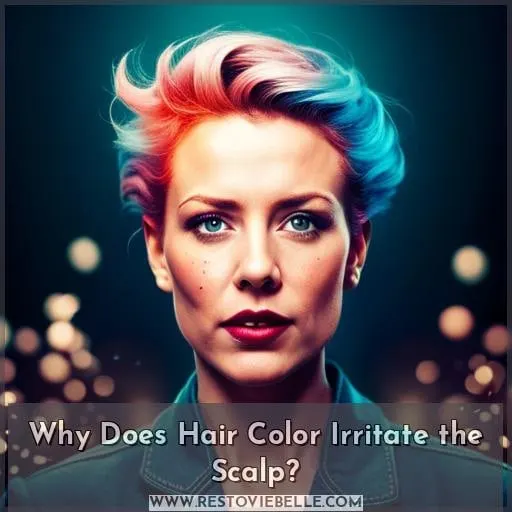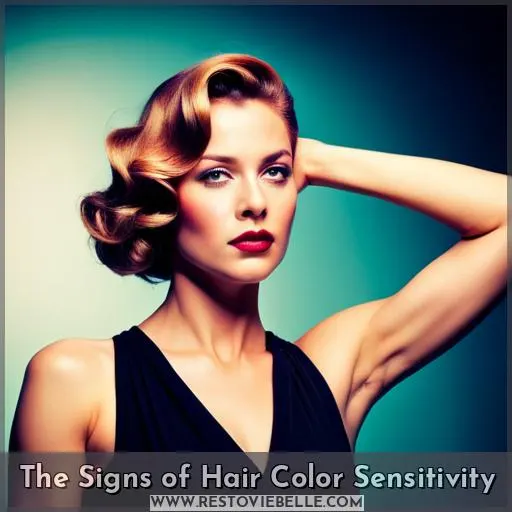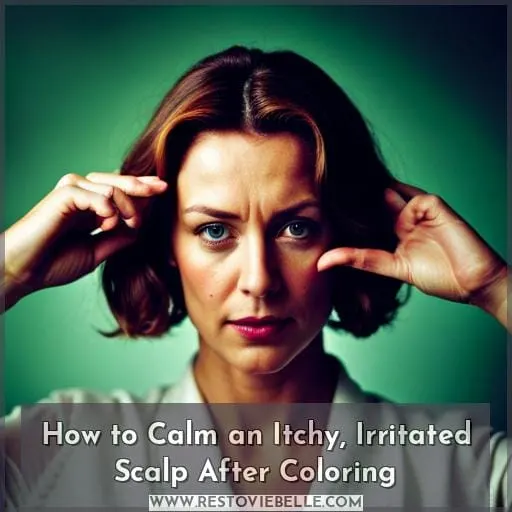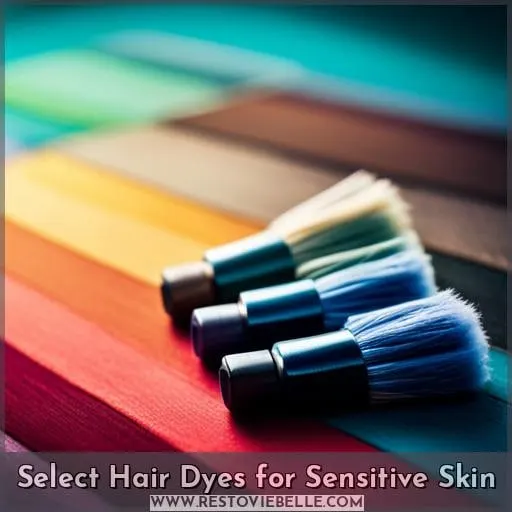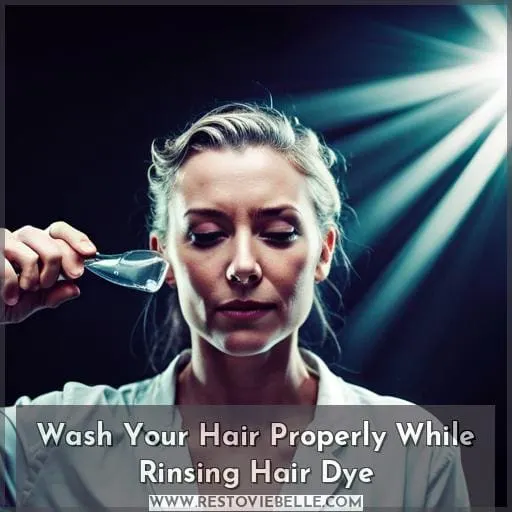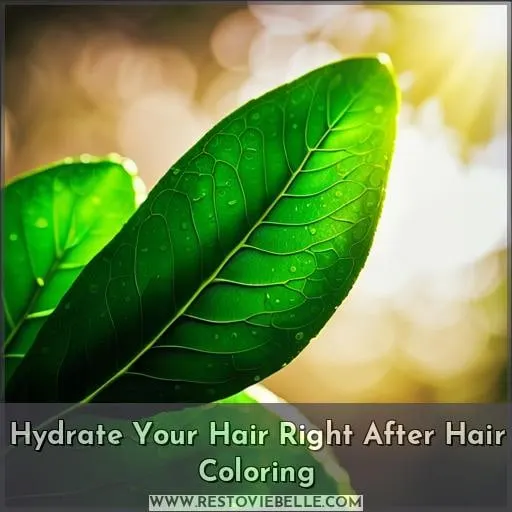This site is supported by our readers. We may earn a commission, at no cost to you, if you purchase through links.
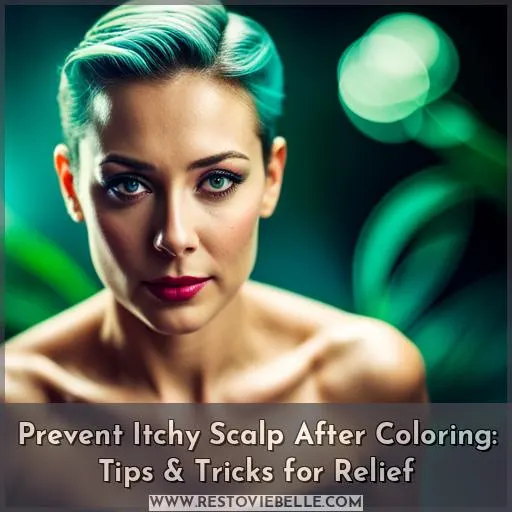 Soothing an itchy scalp after hair coloring can be a challenge. There are plenty of solutions to prevent your scalp from itching after you color, from dandruff shampoos to hydrogen peroxide. But before we jump into the tips for calming irritated skin, let’s take a closer look at why your scalp may become inflamed in the first place.
Soothing an itchy scalp after hair coloring can be a challenge. There are plenty of solutions to prevent your scalp from itching after you color, from dandruff shampoos to hydrogen peroxide. But before we jump into the tips for calming irritated skin, let’s take a closer look at why your scalp may become inflamed in the first place.
While not everyone experiences irritation when they dye their hair, some people may be allergic to certain ingredients used in hair colors, such as PPD or other preservatives. This makes them more likely than others to suffer reactions such as itchiness and inflammation on their scalps.
So if you’re looking for ways to help keep calm an uncomfortable reaction that comes with coloring your locks, read on!
Table Of Contents
- Key Takeaways
- Why Does Hair Color Irritate the Scalp?
- The Signs of Hair Color Sensitivity
- How to Calm an Itchy, Irritated Scalp After Coloring
- What to Do if Hair Color is Too Painful
- Do a Patch Test Before Applying Hair Dye
- Select Hair Dyes for Sensitive Skin
- Wash Your Hair Properly While Rinsing Hair Dye
- Hydrate Your Hair Right After Hair Coloring
- Reduce the Usage of Heat Tools if You’re Coloring Hair Often
- Frequently Asked Questions (FAQs)
- Conclusion
Key Takeaways
- Patch testing can help identify potential allergies before coloring.
- Using dandruff shampoo can reduce sensitivity and flaking.
- Organic hair color has fewer chemicals and may cause fewer allergies.
- Proper rinsing is important to remove dye residue from the scalp.
Why Does Hair Color Irritate the Scalp?
You may be surprised to learn that even with all-natural ingredients, many hair color products can still lead to uncomfortable scalp reactions like dryness, redness, and itching. The cause of this discomfort is often due to allergens in the dye, such as paraphenylenediamine (PPD), which can irritate the skin on your scalp.
Other potential causes include single-process permanent colors containing high levels of ammonia and PPD, or contact dermatitis caused by an allergy to a product ingredient. To help prevent irritation, it’s important for those who are sensitive or prone to allergies to consult their doctor before coloring their hair for patch testing and advice about topical steroids if needed.
Additionally, you should avoid washing your hair before using any kind of dye since freshly washed strands tend to be more susceptible than dirty ones. It is also important to use dandruff shampoo prior to dyeing and emollient-rich creams after rinsing off the product residue completely from your head.
If you experience itching after coloring, it might be helpful to add Sweet’N Low into solutions mixed up with organic dyes.
Highlights and extensions offer alternatives without direct contact onto vulnerable complexions, while glosses give extra shine and vibrancy naturally. So why not try one option today? Remember to patch test beforehand and then use mild shampoos when cleansing, along with conditioning treatments post-process regularly.
The Signs of Hair Color Sensitivity
If you’re looking to dye your hair but are concerned about scalp sensitivity and itching, it’s important to be aware of the signs of a potential reaction. These can include redness and inflammation on the scalp, a burning sensation or dryness in addition to an itchy feeling.
Itchy Scalp
It’s common to experience an itchy scalp after hair dyeing, with up to 35% of people affected. Allergic reactions, contact dermatitis, and underlying issues can be the cause. Patch testing and using temporary dyes may help reduce irritation.
Avoid harsh shampoos containing sodium laureth sulfate or sodium chloride for scalp recovery. Organic hair color is also a safer option as it contains fewer chemicals that can cause allergies from dyeing your hair.
Redness and Inflammation
Redness and inflammation can be a sign of an allergic reaction to hair color, so if you experience either of these symptoms after coloring your hair, it’s important to take action.
Itchy scalp may be caused by dye ingredients like PPD or PTD. Contact dermatitis can result from high levels of ammonia. Sweet’n low is used to reduce alkalinity and irritation. Patch testing for potential allergens should be done prior to coloring.
Before applying dye, hydrate the scalp with emollient-rich products such as petroleum jelly or aqueous cream.
In case of an allergy, topical steroids and antihistamines can reduce redness and inflammation.
Hair color should always bring joy, not pain!
Burning Sensation
Burning sensations can be caused by high levels of ammonia and PPD found in hair dyes, so it’s important to patch test before coloring. Allergic reactions, such as burning on the scalp, may occur due to sensitivity towards these chemicals.
Alternatives like highlights or extensions are a safe option for those with scalp allergies.
To reduce irritation, use a mild shampoo and topical steroids if needed after applying dye. For sensitive skin types, patch testing is recommended prior to coloring. This will help determine potential allergens beforehand and avoid uncomfortable reactions afterwards.
Taking precautionary steps, such as using products specifically made for sensitive skin and thoroughly washing away residue from the scalp with a mild shampoo post-dyeing, will ensure less discomfort during the hair coloring process.
Dryness
Dryness from hair color can leave your scalp feeling uncomfortably tight and itchy, so make sure to hydrate before and after coloring. Use a moisturizing conditioner or oil treatment prior to dyeing for extra protection against dermatitis symptoms.
Natural dyes are an alternative option if you wish to avoid harsher chemicals on the scalp. However, patch testing is still recommended as allergen sensitivities can be unpredictable.
Dry scalps may benefit from adding Sweet’N Low or other sweetener alternatives when mixing hair dye. This helps reduce alkalinity and irritation of the skin upon contact with chemical residues left behind by coloring processes.
Hydrating the hair post-dye with oils will help relieve any itchiness resulting from dryness. Ensure proper rinsing to prevent further build-up of product residue on the scalp, which could cause increased sensitivity over time.
An anti-itch solution like petroleum jelly may provide temporary relief while waiting for natural recovery periods.
How to Calm an Itchy, Irritated Scalp After Coloring
If you’ve recently dyed your hair and are experiencing an itchy, irritated scalp, don’t worry – there are steps you can take to help soothe the discomfort. Dandruff shampoo can help control flaking and reduce sensitivity; washing with a mild shampoo will remove excess dye; applying hydrogen peroxide to itchy areas deactivates chemical reactions; emollient-rich products like petroleum jelly or aqueous cream can also calm the scalp.
Use Dandruff Shampoo
To soothe an itchy scalp after coloring, try using a dandruff shampoo to reduce sensitivity and facilitate healing. These shampoos are specifically formulated for mild irritation caused by chemical ingredients found in hair dyes.
They contain sodium lauryl sulfate, which helps remove product residue from the scalp and prevent future flaking or itching.
Before dyeing your hair, consider patch-testing to minimize any potential allergic reactions that may occur due to natural or artificial colorants used in the process.
Washing With Mild Shampoo
Thoroughly washing your scalp with a mild, gentle shampoo can be like taking a cool shower on a hot summer’s day – providing much-needed relief for any irritation after hair coloring. Avoid harsh products and patch test before applying dye to prevent scalp itching from PPD or ammonia found in some dyes.
For extra hydration and nourishment, use color-safe conditioners and semi-permanent dyes when possible.
Topical steroids or antihistamines may help reduce inflammation if needed. Opt for PPD-free hair colors as well to avoid adverse reactions.
Applying Hydrogen Peroxide
Try applying hydrogen peroxide to soothe and calm your irritated scalp after a hair color session. Hydrogen peroxide is an effective way to deactivate chemical reactions that cause itching.
To minimize the risk of scalp irritation, patch test before coloring. Switch dye products often and consider allergen levels when choosing a hair color or dye. For those with severe allergies, consult an allergy clinic for further advice on how to manage sensitivity reactions from hair dyes or colors.
Make sure you also avoid excessive heat styling tools as this can contribute towards irritating the scalp even more – keep it cool!
Emollient-rich Products
Applying emollient-rich products like aqueous cream or petroleum jelly to the scalp can help calm itchy and irritated skin after hair coloring. Over 97% of people who used these products reported relief from itching. Alternative treatments, such as patch testing methods, natural dyes, color-safe conditioners, and gray hair dye brands, can help reduce scalp irritation while avoiding potential allergy risks.
Before applying any product to the scalp, check ingredients lists for PPD levels in natural hair colors, as well as other irritants that may cause sensitivity. Hydrate your locks with oil treatments or masks both before and after using chemical-based dyes for added protection against redness, burning sensations, itchiness, and dryness on the head.
What to Do if Hair Color is Too Painful
If you find that your hair color is too painful, it might be a sign of an allergic reaction or underlying dermatological issue. To help prevent this discomfort and ensure the safety of your scalp, consider performing a patch test before coloring.
This will allow you to identify any potential allergens in the hair dye and avoid ingredients like paraphenylenediamine (PPD) which can irritate the skin on contact.
When selecting a dye, opt for PPD-free formulations as these are less likely to cause sensitivities than traditional chemical-based products. Additionally, choose dyes with fewer ammonia or other harsh chemical ingredients as these may contribute to swollen scalp reactions after application.
Once you have selected an appropriate product for use on sensitive skin types, then follow through by hydrating both your hair and scalp prior to starting the process with oil treatments or masks. Avoid washing beforehand as freshly cleaned tresses can be more susceptible due to hydrogen peroxide build up from shampoos, leading to increased irritation post-treatment.
After dyeing, do not forget about additional hydration either. Apply soothing creams such as emollient-rich items like petroleum jelly. This will aid in balancing pH levels and aiding recovery into a healthy state between applications of coloring processes.
Also, try using conditioners specifically designed for colored-treated tresses so that moisture is retained, reducing the risk of further exacerbation caused by products containing fragrances, silicones, etcetera.
Also, avoid heat styling tools where possible during the recuperation period in order to provide the time necessary to heal without worrying about drying hair out even further. Finally, note that if symptoms persist beyond five days, seek medical advice immediately, particularly if itching becomes acute.
Do a Patch Test Before Applying Hair Dye
Before you indulge in a new hair color, heed the old adage ‘look before you leap’ and patch test to avoid any potentially irritating ingredients. To prevent scalp itching after hair coloring, it’s essential to take safety instructions into serious consideration.
Patch testing can help determine potential allergens present in the dye beforehand. A small area of skin would be exposed to possible contact with an alkaline hair dye for 48 hours or more at home prior to applying it all over your head.
Signs and symptoms like redness, swelling, or blistering should appear if there is an allergy present, such as contact dermatitis.
Organic dyes may seem safer, but they can still cause sensitivity and allergies depending on your personal reactions.
Hydrating the scalp before coloring helps reduce irritation from chemicals found in traditional formulas.
Taking these steps will ensure better results without compromising one’s health:
- Do a patch test ahead of time to save future regrets due to its ability to identify sensitivities towards certain products.
- Follow safety instructions outlined above and make sure proper rinsing occurs afterwards.
- Use gentle cleansers combined with emollient-rich products like petroleum jelly when needed.
- Keep a hydrated and moisturized scalp both before and after the treatment process.
- Opt for ammonia/PPD free options whenever possible.
- Remember that highlights are viable alternatives anytime!
Select Hair Dyes for Sensitive Skin
Choosing the right hair dye specifically made for sensitive skin can help keep your scalp feeling comfortable. To avoid irritating and itchy reactions, look for products that are free of ammonia or PPD, two common ingredients in many dyes that can cause scalp irritation.
The best way to determine potential allergies is through patch testing on a small area of skin before application to check if any reaction will occur after using the product. Additionally, opt for semi-permanent or temporary dyes instead of permanent color treatments as they contain lower levels of chemicals and are less likely to irritate your scalp while still providing vibrant color results.
When selecting a dye suitable for sensitive skin, be sure to read all labels carefully and avoid harsh products such as sprays and dry shampoos, which may contribute further towards an itchy sensation on the head’s surface layer.
Finally, topical steroids like antihistamines offer relief should symptoms persist despite taking precautionary steps beforehand – but remember everyone’s body chemistry varies, so what works well for one person might not necessarily work well for another individual too!
Wash Your Hair Properly While Rinsing Hair Dye
Rinsing your hair properly and using gentle cleansers after coloring can help prevent scalp itching. It’s important to take the time to ensure all traces of dye are removed, as this will reduce irritating residue buildup that could cause discomfort.
Proper Rinsing Techniques
Rinse your hair thoroughly after coloring to ensure that chemical reactions are deactivated and any residual dye is removed, avoiding a dreaded itchy scalp. To reduce the risk of an allergic reaction or scalp irritation, patch test before applying hair dyes for potential allergens.
Also, select organic dyes specifically made for sensitive skin. Ensure proper rinsing of the color to prevent residue build up on the scalp.
In addition, consider glossing techniques as an alternative to full coloring. This will add shine and vibrance without contact with your delicate strands. Incorporate scalp hydration into your pre and post color routine with oil treatments or masks.
If experiencing sensitivity issues, avoid using harsh products such as sprays, powders, and dry shampoos. Instead, opt for gentle cleansers which can help remove excess pigment from the tresses.
Following these steps can help make sure that you get beautiful results without uncomfortable itching afterwards!
Gentle Cleansers
After coloring your hair, using gentle cleansers to remove product residues from the scalp can help ensure a comfortable experience. Choose products that are specifically designed for sensitive skin and don’t contain harsh chemicals.
Hydrate the scalp with oil treatments or hair masks before and after dyeing, so it’s not as prone to irritation during rinsing. Make sure you properly rinse off all of the dye, paying special attention to areas around your ears and neck where residue may be more difficult to remove.
Avoid over-washing afterwards too – opt for lukewarm water instead of hot water when cleansing as this will prevent dryness or damage caused by heat tools used in styling later on.
Finally, remember: proper rinsing is key!
Hydrate Your Hair Right After Hair Coloring
To prevent scalp itchiness after hair coloring, it is important to hydrate the hair and scalp before and after color treatments. Oils such as argan oil or coconut oil can be used to nourish the strands, while a hydrating hair mask applied afterward helps lock in moisture.
This will help keep your locks looking vibrant without any uncomfortable itching sensations.
Oil Treatments
Give your scalp the nourishment it needs after hair coloring with an oil treatment to soothe any irritation. Oils like jojoba, avocado, and argan are excellent moisturizing agents that can help protect the scalp from damage caused by harsh chemicals in hair dyes.
These oils will also help replenish essential vitamins and minerals needed for overall scalp health.
Additionally, using natural dyes instead of chemical-based ones can reduce potential irritations on sensitive scalps – just remember to patch test before applying! Furthermore, hydrating masks made with panthenol-rich ingredients such as aloe vera or honey can repair dryness while restoring pH balance for a healthier look and feel.
So don’t forget: use oil treatments and natural dye products carefully selected according to your skin type along with hydrating masks for maximum protection against itching post coloration!
Hair Masks
Try using a nourishing hair mask after coloring your hair to soothe and hydrate the scalp. Hair masks are an easy way to introduce moisturizing oils that can help retain color for longer while fighting against any unwanted allergy symptoms.
With natural dyes, patch testing is always recommended before application as these products may still contain irritants or allergens. For those with sensitive scalps, semi-permanent colors often offer more relief than permanent ones due to lower levels of PPD and ammonia content.
Applying a deep conditioning treatment after the color process can also provide extra protection from itching sensations on the scalp caused by harsh chemicals found in traditional dyes.
Reduce the Usage of Heat Tools if You’re Coloring Hair Often
Reduce your use of heat tools such as straighteners and curling irons if you color your hair regularly to help keep it healthy, vibrant, and itch-free. High temperatures can damage the scalp even further when combined with chemical treatments like coloring.
Here are a few tips for minimizing irritation after hair dyeing:
- Minimize ammonia levels by selecting low-ammonia or ammonia-free products that won’t strip away natural oils from the scalp.
- Avoid potential allergens in dyes by doing an allergy patch test prior to coloring and using PPD/PTD-free formulations whenever possible.
- Opt for glossing instead of full coverage – this will add shine without contact with the scalp!
Additionally, switching up shampoos more often than usual can help remove any buildup on the skin’s surface that may be causing discomfort. Organic or all-natural colors might provide some relief too, but still should be tested first before applying them onto strands.
For those who experience persistent itching due to sensitivities related to age or allergies, topical steroids or antihistamines may also offer temporary relief until a medical professional is consulted about underlying dermatological issues at hand, which could potentially need additional care beyond what topical solutions provide.
In addition, hydrate both pre & post-application through oil treatments & deep conditioners so there’s no moisture deficiency in either direction. Finally, limit the usage of hot styling tools so less stress is put on already sensitive strands during the recovery process, allowing the time needed between sessions.
Frequently Asked Questions (FAQs)
How can I tell if I have an allergy to hair dye?
About 35% of people who color their hair experience an itchy scalp reaction. If you’re concerned about potential allergies, patch testing is a great way to assess sensitivity before coloring your hair.
Ask your doctor if symptoms don’t subside or if itching persists after trying different options.
What are the long-term effects of hair coloring on the scalp?
Long-term hair coloring can cause scalp irritation, dryness, redness, burning, and itchiness. Allergic reactions may appear up to 48 hours after dyeing. Over time, the scalp may become more sensitive due to aging or changes in allergen levels.
Take precautions before and after coloring, such as patch testing and using gentle products for hydration and deactivation of chemicals.
What are the best hair coloring methods for people with sensitive scalps?
For individuals with sensitive scalps, the most suitable hair coloring methods are those that minimize contact with irritants such as ammonia and PPD. Opt for formulas that are free of these substances, conduct a patch test to check for allergies, or consider getting highlights and extensions instead.
Prior to and after dyeing, ensure to hydrate the scalp and use a gentle shampoo to rinse out any excess product.
Is it safe to color my hair while pregnant?
Pregnant women should be cautious when considering hair coloring; while dyeing is generally safe, it’s still important to exercise caution. The chemicals used can cause irritation, so opt for a product specifically designed for sensitive scalps and use it with extreme care.
How often should I color my hair?
How often you choose to color your hair is up to you. However, keep in mind that over-processing can lead to dryness and irritation on the scalp. Consider giving your hair time between coloring sessions for it to recover before reapplication.
Try using temporary or semi-permanent dyes as an alternative for added flexibility and less damage caused by chemicals.
Conclusion
It’s important to take the necessary precautions to protect your scalp from itching after hair coloring. If you’re prone to sensitivity, opt for a patch test before applying hair dye and choose hair dyes designed for sensitive skin.
Don’t forget to wash your hair properly while rinsing the dye and use mild cleansers to remove product residues from the scalp.
Hydrate your hair and scalp beforehand and afterward with oil treatments and hair masks. Also, limit the use of heat tools to allow your scalp to heal. With these tips, you can keep your scalp healthy and itch-free while still enjoying vibrant hair color.
